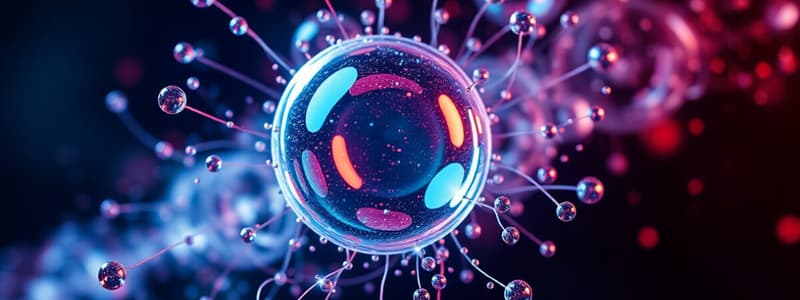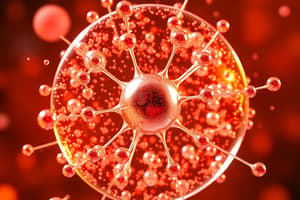Podcast
Questions and Answers
Which of the following statements correctly describes the particle arrangement in liquids?
Which of the following statements correctly describes the particle arrangement in liquids?
- Particles are far apart and move randomly with no attractive forces.
- Particles are tightly packed and can only vibrate in fixed positions.
- Particles are closely packed but can move past each other. (correct)
- Particles are arranged in regular rows and columns.
According to particle theory, a vacuum contains particles that are too small to observe.
According to particle theory, a vacuum contains particles that are too small to observe.
False (B)
Explain why gases can be easily compressed, according to particle theory.
Explain why gases can be easily compressed, according to particle theory.
Particles in a gas are far apart with no attractive forces, allowing them to be pushed closer together.
The particles in a ______ are held together by strong attractive forces, restricting their movement to vibrations only.
The particles in a ______ are held together by strong attractive forces, restricting their movement to vibrations only.
Match each state of matter with the correct description of particle movement:
Match each state of matter with the correct description of particle movement:
Which property of matter is best explained by the ability of particles to move past one another?
Which property of matter is best explained by the ability of particles to move past one another?
Which of the following properties is unique to gases compared to solids and liquids?
Which of the following properties is unique to gases compared to solids and liquids?
Liquids maintain their volume regardless of the container shape.
Liquids maintain their volume regardless of the container shape.
What term is used to describe anything that has mass and takes up space?
What term is used to describe anything that has mass and takes up space?
Unlike solids, liquids can be easily ______.
Unlike solids, liquids can be easily ______.
Match the state of matter with its defining property:
Match the state of matter with its defining property:
Which of the following is an example of a property shared by both liquids and gases?
Which of the following is an example of a property shared by both liquids and gases?
If a scientist observes that a substance maintains a constant volume but changes shape depending on its container, which state of matter is the substance most likely in?
If a scientist observes that a substance maintains a constant volume but changes shape depending on its container, which state of matter is the substance most likely in?
The volume of a solid changes depending on the container it is placed in.
The volume of a solid changes depending on the container it is placed in.
Which is a key difference between solids and gases regarding compression?
Which is a key difference between solids and gases regarding compression?
Which of the following best describes what happens to the particles when a liquid turns into a solid?
Which of the following best describes what happens to the particles when a liquid turns into a solid?
According to the particle theory, particles in a gas touch each other.
According to the particle theory, particles in a gas touch each other.
What is the key difference in the arrangement of particles between a solid and a liquid?
What is the key difference in the arrangement of particles between a solid and a liquid?
A scientific __________ is a suggested explanation that can be tested through investigations.
A scientific __________ is a suggested explanation that can be tested through investigations.
What happens to most substances when they are heated?
What happens to most substances when they are heated?
Match the state of matter with the description of its particle arrangement:
Match the state of matter with the description of its particle arrangement:
What is a scientific hypothesis called when it has been tested and widely accepted by other scientists?
What is a scientific hypothesis called when it has been tested and widely accepted by other scientists?
Briefly explain what the particle theory is.
Briefly explain what the particle theory is.
Liquids always turn into solids if you heat them.
Liquids always turn into solids if you heat them.
In which state of matter do particles vibrate in a fixed position?
In which state of matter do particles vibrate in a fixed position?
Flashcards
What is Matter?
What is Matter?
Anything that has mass and takes up space.
States of Matter
States of Matter
The three physical forms that matter can exist in: solid, liquid, and gas.
Solid
Solid
A state of matter that has a fixed shape and volume; cannot be compressed or poured.
Liquid
Liquid
Signup and view all the flashcards
Gas
Gas
Signup and view all the flashcards
Properties of Matter
Properties of Matter
Signup and view all the flashcards
Compress
Compress
Signup and view all the flashcards
Pour
Pour
Signup and view all the flashcards
Volume
Volume
Signup and view all the flashcards
Flow
Flow
Signup and view all the flashcards
Change Volume
Change Volume
Signup and view all the flashcards
Vacuum
Vacuum
Signup and view all the flashcards
What is a hypothesis?
What is a hypothesis?
Signup and view all the flashcards
What is a scientific theory?
What is a scientific theory?
Signup and view all the flashcards
What is particle theory?
What is particle theory?
Signup and view all the flashcards
Particle arrangement in solids?
Particle arrangement in solids?
Signup and view all the flashcards
Particle arrangement in liquids?
Particle arrangement in liquids?
Signup and view all the flashcards
Particle arrangement in gases?
Particle arrangement in gases?
Signup and view all the flashcards
What is particle vibration?
What is particle vibration?
Signup and view all the flashcards
Effect of heat on matter?
Effect of heat on matter?
Signup and view all the flashcards
What is evaporation?
What is evaporation?
Signup and view all the flashcards
What is freezing?
What is freezing?
Signup and view all the flashcards
Study Notes
- Matter is everything that can be seen and felt.
- Scientists classify matter into three states: solids, liquids, and gases.
- The way matter behaves defines its properties.
Solids
- Have a fixed shape and volume
- Cannot be compressed or poured
- Particles are arranged in a fixed pattern
- Particles are held together strongly and are tightly packed
- Particles vibrate (make small movements) but stay in the same place
- Cannot flow
Liquids
- Take the shape of their container
- Can be poured, but cannot be compressed
- Have a fixed volume that doesn't change, regardless of the container
- Particles touch each other but can move past one another
- Particles are held together weakly, allowing them to move around
Gases
- Flow like liquids and fill any closed container
- Volume can change and are very easy to compress
- Weigh very little, are often invisible, but can sometimes be smelled
- Particles do not touch each other and are far apart
- Particles spread out and move quickly in all directions
Particle Theory
- Matter is made of tiny particles that are too small to see
- These particles are arranged differently in solids, liquids, and gases
- Explains how matter behaves using the idea of particles, which are tiny portions of matter
Hypothesis and Theories
- Hypothesis is a suggestion for an explanation of observed phenomena
- A theory is formed when a hypothesis has been tested and widely accepted as valid
Other
- Matter can only flow if the particles can move past one another
- Matter can only change volume if the particles can spread out or move closer together
- A space where there are no particles at all is called a vacuum, which contains nothing
Studying That Suits You
Use AI to generate personalized quizzes and flashcards to suit your learning preferences.




